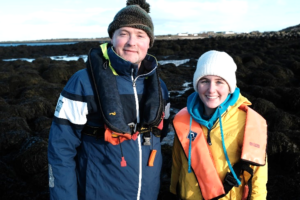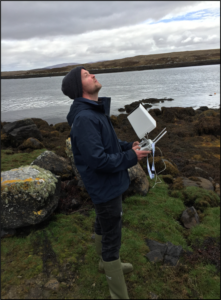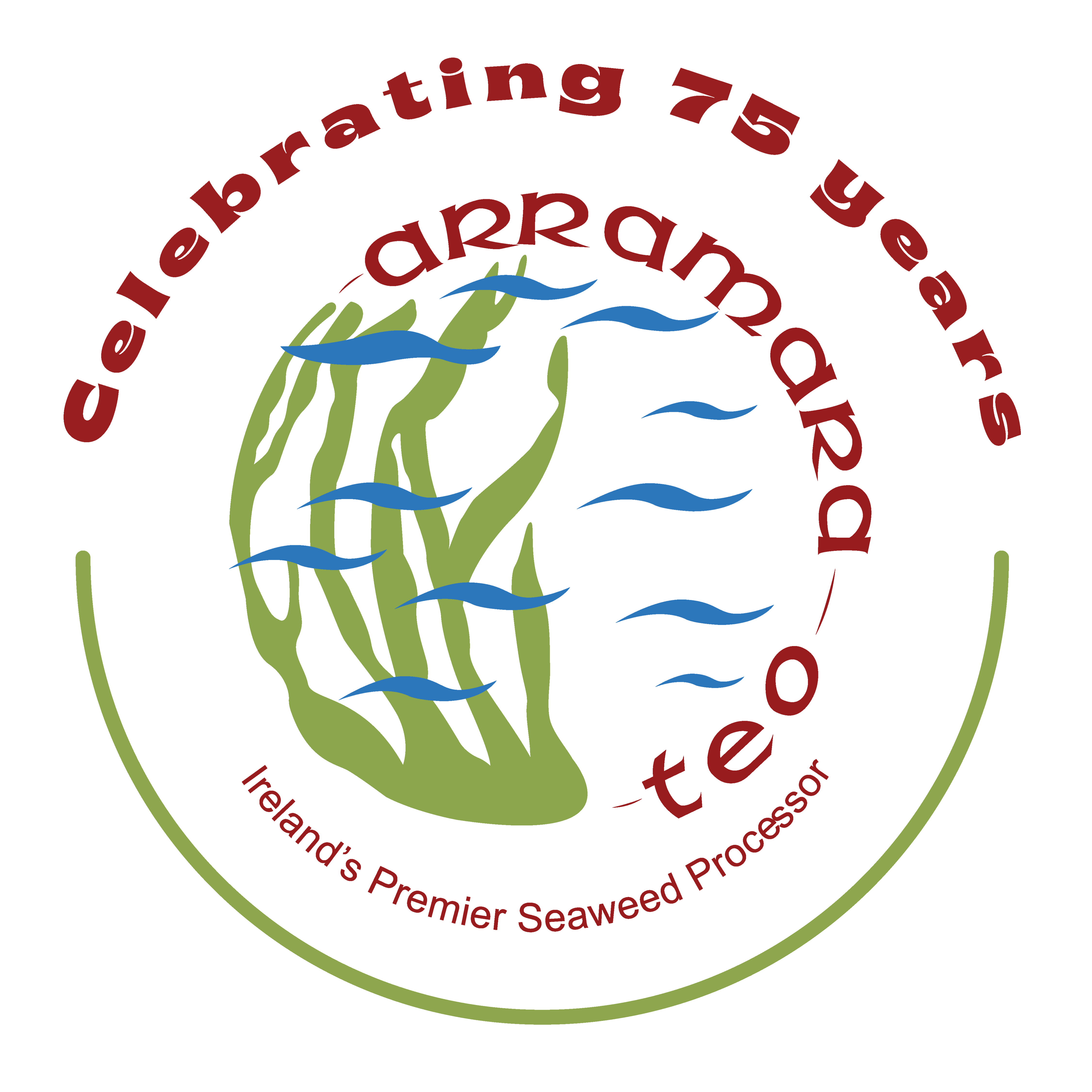If you haven’t spent much time studying seaweed, you might be surprised by how complicated this marine resource can be. Different species have unique growing conditions, biological properties, and benefits to human beings. For an organization like Arramara Teoranta to truly understand the complexities of Ascophyllum nodosum and how our sustainable harvesting methods influence the ecosystem, we need in-house experts who can guide us through conscious stewardship.
One of those people is Micheál Mac Monagail, our Resource Scientist at Arramara Teoranta, who recently obtained his Ph.D. through the National University of Ireland, Galway (NUIG). Proud of the hard work he’s done, we wanted to take a few moments to talk with Micheál about the seaweed research papers included in his Ph.D. work, what he’s learned on the job and in academia, and how he’s grown with Arramara. Here’s our conversation:
Arramara: Hello Micheál! Congratulations on earning your Ph.D.! What did your thesis work cover?
Micheál: Thank you! The title of my thesis is A Modern Perspective of the Seaweed Landscape of Ireland. It covered a lot of bases. There were some biological papers, chemistry papers, and a couple of papers on seaweed management in Ireland within the final manuscript and recommendations on improving works in Ireland. They are broad strokes. I’m not specifically a chemist or a biologist, but I touch on everything.
The idea, more or less, was to review seaweed management in Ireland from a historical perspective and maybe point out how best to improve on the lack of coherent management here. We looked at some of the chemical characteristics of Ascophyllum, how that relates to animals that consume our seaweed meal, and what that means for humans who then go on to eat the animals. What we found in our analyses is that animal products whose diets are supplemented with seaweed meal are perfectly safe for humans to consume. This builds on prior published data on the health benefits of consuming seaweed.
As a seaweed resource scientist, I do a lot of work using drones and satellites to assess seaweed resources in Ireland. At the moment, the way I and several others at the company do our jobs is through laborious and time-consuming methods. We visit and walk the shore, following that pattern in coastal locations all around Ireland. The idea behind some of the work and thesis is, “Can we utilize earth observation satellites to help us in our work and look at larger spatial scales?” With the research I’ve conducted, it turns out we can.
Arramara: Does this technology broaden the range of Arramara’s harvesting in Ireland? Since you can identify sites, you maybe weren’t aware of previously?
Micheál: Using something like a drone is great on small spatial scales. Maybe one little shoreline, but not ideal for Ireland when we have over 5,000 kilometres of shoreline on the west coast. Using a satellite is excellent because we can image a vast area all at once, and we get these tiles of over hundreds and hundreds of kilometres. We can get an excellent idea of where seaweed is in Ireland.
 We’ve learned that you’ll still need fieldwork and guys like me and our resource technician, Toni Kennedy, to go to the shore, visit these areas, and assess them. Satellite imaging contributes to the work we do, but you’re never going to get away from having boots on the ground — as they say. It does, however, help us to see where a resource is that we didn’t know about before. It can be used to assess where different seaweed resources are. We have primarily used Ascophyllum, but using satellites and drones, you can assess other seaweed species at the same time.
We’ve learned that you’ll still need fieldwork and guys like me and our resource technician, Toni Kennedy, to go to the shore, visit these areas, and assess them. Satellite imaging contributes to the work we do, but you’re never going to get away from having boots on the ground — as they say. It does, however, help us to see where a resource is that we didn’t know about before. It can be used to assess where different seaweed resources are. We have primarily used Ascophyllum, but using satellites and drones, you can assess other seaweed species at the same time.
Again, it helps us and our work. These technologies contribute to the everyday work that we use. Now, they’re something we use every day. In fact, I’m using this technology right now to assess some kelps because it saves me driving thousands of miles at a time. I can just check the satellite and go, “Okay, there’s kelp in this little bay here.” And then I can go and check it out precisely rather than trying to find it.
Arramara: We imagine this was helpful while you were trying to balance the work of your job while also pursuing the Ph.D. Did the technology help you to use your time more cost-effectively?
Micheál: Yeah, it was tricky. There were a couple of moments, not going to lie, when things got hairy, but definitely, I was quite lucky to be working with this company, both Arramara and Acadian. As well as the guys in the resource science group like Dr. Raul Ugarte and Dr. Jean-Sebastien Lauzon-Guay, and many others. They were super helpful all the time. Anything I needed, they had my back and were a good resource. These guys are the best at what they do.
For sure, it’s a balance. I did a lot of Ph.D. work in the evening and on weekends. At the end of the day, working for Arramara pays the bills and is the priority. It was a heavy lift since I was at it all the time for five years. But our great team always helped me out.
My wife and I had a baby a few months ago, which made things a little trickier. Plus, I got married and all the rest. Looking back a year later, I’m not sure how I did it all at the same time (laughs).
Arramara: Do you have any further goals for ongoing education? Or are you looking to take a break for a bit?

Micheál: Short answer is no; I don’t want to open a book ever again (laughs). But in reality, yeah. A lot of these different tools and GIS, that’s an ever-evolving technology, means you have to learn all the time to keep on top of these innovations. I try to improve on these technologies all the time, but before I did the Ph.D., I obtained a class-taught Masters in Bioenergy, and I did a research Masters after that in Crop Stress Biology. I’m done at this stage. I now want to continue to improve my skills as a resource scientist, helping to grow Arramara Teoranta while ensuring the sustainability of our natural resources. Plus, I have the chance to learn from the incredible people around me.
Arramara: Is there any way that your Ph.D. has further expanded your perspective about the work you do?
Micheál: Before I started at Arramara, I had my own little business drying seaweed, trying to produce a dry powder. I was also producing a seaweed extract in a lab in Aberystwyth, Wales, where I used to study. So, I did that for three years, and I didn’t make any money (laughs). Didn’t make a penny. But seeing that side of the industry was an excellent experience.
When I did start at Arramara, I was green. There was so much good work previously done on seaweed in Ireland that I wasn’t aware of. Being at NUIG, I was in a really good group of scientists. My supervisor, Dr. Liam Morrison, is an excellent scientist. His past supervisor, Prof. Mike Guiry, is one of Ireland’s most highly respected phycologists. Now, they’re both good friends. Working with these guys was excellent. I’m focused on Ascophyllum resource assessments, but there are a million other things related to seaweed out there to study.
Looking at how seaweed regrows is one thing but looking at the bigger picture of how harvesting seaweed impacts invertebrates, fish, birds, and other living things is something I would have never considered. Now, it’s great that we know the impact of harvesting is minimal, thanks to work carried out by other scientists in the field; it’s just something which wouldn’t have come into my mind. That’s definitely one of the bigger things: getting a more rounded idea of the commercial industry. Seeing all the good work done and the incredible science. It’s inspirational as well. You always want to get better, producing good papers and good science. Not just coasting along or publishing in any old ‘Mickey Mouse’ journal.
What I found is that a lot of people who are doing a Ph.D. are not necessarily geniuses, and nobody knows everything. You just don’t. You have to learn these things and work hard at it. You find out you can do anything as long as you sit down and try to figure things out. Even stuff I’m doing at the moment, trying to use various algorithms to classify seaweed, a few months ago, I would have said I’m never going to bloody well be able to do that. You learn, isn’t that it? The Ph.D. gives you the tools to be confident in your own abilities.
Arramara: Thanks to Micheál for taking some time to talk with us, as well as always working hard to grow your knowledge and ours.
Micheál Mac Monagail and his seaweed research papers are only part of the incredible innovations happening at Arramara. Every member of our team is working to do things better, smarter and safer than the day before.
Meet the Arramara Team
Related Articles
How Maura Flaherty & Arramara’s Manufacturing Workplace Safety Support Our Workers & Community
Meet Toni Kennedy: Arramara Teoranta’s New Field Technician
Saved by Seaweeds: their important contributions in times of crisis!
